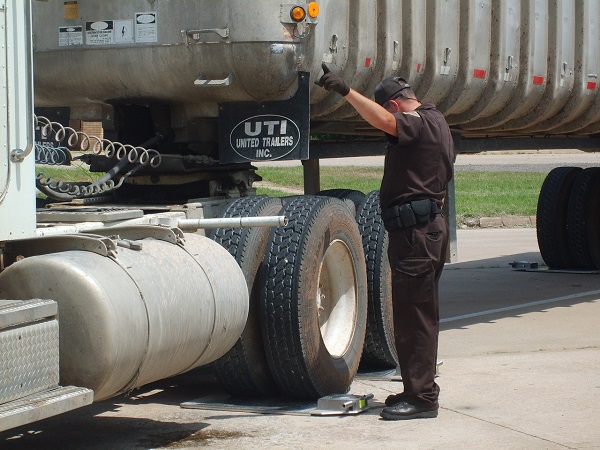Roadside Inspection Program
Oklahoma Highway Patrol, Troop S
The Troop S roadside inspection program comprises State Troopers strategically placed throughout the state. Troop S personnel are dedicated to Commercial Motor Vehicle (CMV) enforcement activities, including size and weight activity. Troop S is able to enforce Federal Motor Carrier Safety Administration (FMCSA) federal safety regulations in addition to state laws to help reduce injury and fatality collisions. All Roadside Inspectors, Safety Auditors, and Compliance Review investigators meet FMCSA and Commercial Vehicle Safety Alliance standards and certification requirements.
Commercial Vehicle Traffic Enforcement Program (CVTEP)
Troopers from various fields throughout the state are assigned part-time to the Commercial Vehicle Traffic Enforcement Program (CVTEP). CVTEP Troopers meet the North American Standard Level I Inspection certification requirement. CVTEP allows Troop S to provide additional enforcement personnel in areas of the State. CVTEP Troopers can conduct inspections through a random selection of commercial motor vehicles. Members of CVTEP also provide additional enforcement for seat belts and traffic compliance. This program fulfills the Oklahoma Highway Patrol (OHP) career path for Troopers wanting to become full-time CMV Enforcement Troopers. CVTEP Troopers are given an opportunity to become certified in Hazardous Material (HM) and Cargo Tank inspections as classes are offered.
Traffic Trooper Enforcement Program (TTEP)
To further enhance the traffic enforcement efforts of Troop S, the Traffic Trooper Enforcement Program (TTEP) has been implemented to train field traffic Troopers to conduct roadside inspections with the goal of reducing the number of collisions involving CMVs. TTEP Troopers are primarily used in traffic enforcement/driver behavior type inspections. TTEP Troopers can conduct random inspections on those necessary for annual certification. Still, all other inspections must have a state probable cause violation or a visible Federal regulation violation before making a stop and conducting an inspection on a CMV.
Port of Entry (POE)
Troop S has implemented the Port of Entry (POE) program. These employees are trained and certified in North American Standard Inspections as CMV inspectors at the Beckham, Kay, Love, Sequoyah, and Bryan County's ports of entry.

Levels of Roadside Inspections
- Level I
North American Standard Inspection – An inspection that includes an examination of driver’s license; medical examiner’s certificate and Skill Performance Evaluation (SPE) Certificate (if applicable); alcohol and drugs; driver’s record of duty status as required; hours of service; seat belt; vehicle inspection report(s) (if applicable); brake systems; coupling devices; exhaust systems; frames; fuel systems; lighting devices (headlamps, tail lamps, stop lamps, turn signals, and lamps/flags on projecting loads); securement of cargo; steering mechanisms; suspensions; tires; van and open-top trailer bodies; wheels, rims and hubs; windshield wipers; emergency exits and/or electrical cables and systems in engine and battery compartments (buses), and HM/DG requirements as applicable. HM/DG required inspection items will be inspected by certified HM/DG inspectors.
- Level II
Walk-Around Driver/Vehicle Inspection – An examination that includes each item specified under the North American Standard Level II Walk-Around Driver/Vehicle Inspection Procedure. As a minimum, Level II inspections must include examination of a driver’s license, medical examiner’s certificate, and Skill Performance Evaluation (SPE) Certificate (if applicable); alcohol and drugs; driver’s record of duty status as required; hours of service; seat belt; vehicle inspection report(s) (if applicable); brake systems; coupling devices; exhaust systems; frames; fuel systems; lighting devices (headlamps, tail lamps, stop lamps, turn signals and lamps/flags on projecting loads); securement of cargo; steering mechanisms; suspensions; tires; van and open-top trailer bodies; wheels, rims and hubs; windshield wipers; emergency exits and/or electrical cables and systems in the engine and battery compartments (buses), and HM/DG requirements as applicable. HM/DG required inspection items will be inspected by certified HM/DG inspectors. It is contemplated that the walk-around driver/vehicle inspection will include only those items that can be inspected without physically getting under the vehicle.
- Level III
Driver/Credential Inspection – An examination that includes those items specified under the North American Standard Level III Driver/Credential Inspection Procedure. As a minimum, Level III inspections must include, where required and/or applicable, an examination of the driver’s license; medical examiner’s certificate and Skill Performance Evaluation (SPE) Certificate; driver’s record of duty status; hours of service; seat belt; vehicle inspection report(s); and HM/DG requirements. Those items not indicated in the North American Standard Level III Driver/Credential Inspection Procedure shall not be included in a Level III inspection.
- Level IV
Special Inspections – Inspections under this heading typically include a one-time examination of a particular item. These examinations are normally made to support a study or verify or refute a suspected trend.
- Level V
Vehicle-Only Inspection – An inspection that includes each vehicle inspection item specified under the North American Standard Inspection (Level I), without a driver present, conducted at any location.
- Level VI
North American Standard Inspection for Transuranic Waste and Highway Route Controlled Quantities (HRCQ) of Radioactive Material – An inspection for select radiological shipments, which includes inspection procedures, enhancements to the North American Standard Level I inspection, radiological requirements, and the North American Standard Out-of-Service Criteria for Transuranic Waste and Highway Route Controlled Quantities (HRCQ) of Radioactive Material.
As of January 1, 2005, all vehicles and carriers transporting highway route-controlled quantities (HRCQ) of radioactive material are regulated by the U.S. Department of Transportation and must pass the North American Standard Level VI Inspection.
Previously, the U.S. Department of Energy (DOE) voluntarily complied with the North American Standard Level VI Inspection Program requirements.
Select radiological shipments include highway route controlled quantities (HRCQ) of radioactive material as defined by Title 49 CFR Section 173.403. And, because only a small fraction of transuranic are HRCQ, DOE has decided to include its transuranic waste shipments in the North American Standard Level VI Inspection Program.


